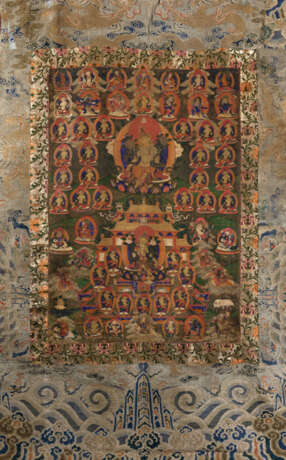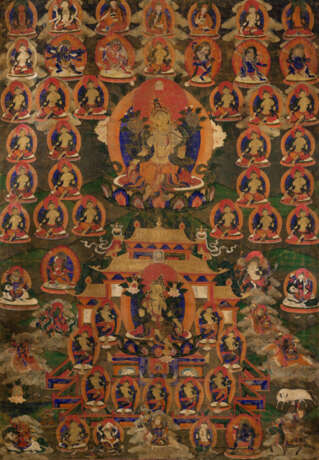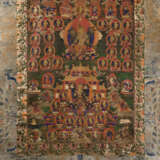ID 83511
Lot 111 | Aspekte der Tara - Schutz und Wohlstand
Estimate value
€ 4 000 – 6 000
Dieses großdimensionierte Thangka zeigt die Grüne Tara mit ihren 21 Emanationen nach der Tradition Atisha's. Der Legende nach ist die Tara aus Tränen des Mitgefühls des Bodhisattva Avalokiteshvara entstanden. Eine andere Legende erzählt die grüne Tara habe vor vielen Zeitaltern als Prinzessin Jnanachandra viele Verdienste erlangt. Mönche, die dies erkannten, drängten die Prinzessin dazu, um eine Wiedergeburt als Mann anzustreben, damit sie so die volle Erleuchtung erlangen könne. Die Prinzessin lehnte dies aber ab, bezeichnete die Unterschiede zwischen den Geschlechtern als Trugbild und legte das Gelübde ab, um bis zur Befreiung aller Wesen fortan in einem weiblichen Körper zu wirken. Das Motiv ihrer Aktivität ist Mitgefühl, um Hilfe aus der Not, und Beistand bei Gefahren, die den Wesen auflauern, zu gewähren. Die 21 Emanationen deuten auf ihre vielfältige Wirkungsweise. Jede der 21 Taras hat einen eigenen Namen mit dem sie in entsprechenden Situationen und Bedürfnissen angerufen werden können. Neben der Grünen und Weißen Tara gibt es auch gelbe, rote und blaue Emanationen, die jeweils bestimmte Aspekte des Wirkens der Gottheit verkörpern. In diesem Thangka zeigt sich die Tara, neben ihrer Schutz-Gewährung, in einer weiteren Funktion, in Gestalt der Vasundhara, der Gottheit des Wohlstands. Diese residiert im Zentrum der Malerei, in ihrem eigenen Buddhafeld, in einem mit Mauern umfriedeten Golddachtempel. Inmitten dieses Tempels erscheint sie, ihre Attribute Schatzvase und Wunschjuwel in Händen haltend, umgeben von neun Emanationen die in Gestalt von Dakinis in Tanzpose über goldenen Schatzvasen schweben. In ihren Händen halten sie Garben aus Ähren, als Sinnbilder für Fruchtbarkeit, und goldene Schatzvasen, Symbole von Reichtum und Wohlstand. Über der Versammlung der 21 Taras erscheinen zahlreiche Buddhas; Bodhisattvas; tantrische Gottheiten und Padmasambhava in der Mitte, flankiert von einem Patriarchen der Sakya-Schule. Im Umkreis des Palastes sind Reichtums- und Langlebensgottheiten zu erkennen sowie Dharmaschützer. Rechts unten ist eine Bäuerin abgebildet die eben ihre Milchkuh melkt. Links unten sitzt ein Mönch, und darüber, ganz klein und bescheiden, ein Bittsteller auf einer weißen Lotosblume, vielleicht der Stifter dieser Thangkamalerei? Tempera und Gold auf Baumwollgewebe, Originale Goldbrokat-Einfassung (!), mit Schutztuch.
Provenienz: Aus einer alten europäischen Privatsammlung - Etwas berieben, Altersspuren
92 x 65/160 x 119,5
| Address of auction |
LOFT Salzburg Müllner Hauptstrasse 1 5020 Salzburg Austria | ||||||||||||||
|---|---|---|---|---|---|---|---|---|---|---|---|---|---|---|---|
| Preview |
| ||||||||||||||
| Phone | +43 662 243045 | ||||||||||||||
| Conditions of purchase | Conditions of purchase | ||||||||||||||
| Shipping |
Postal service Courier service pickup by yourself | ||||||||||||||
| Payment methods |
Wire Transfer | ||||||||||||||
| Business hours | Business hours
|





